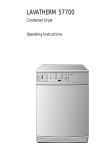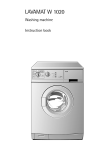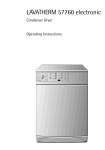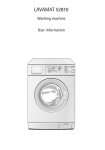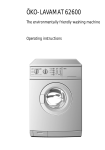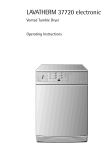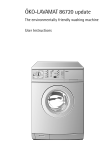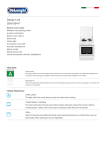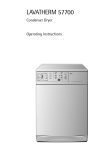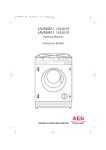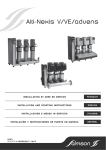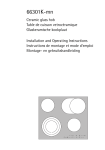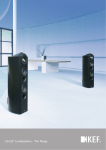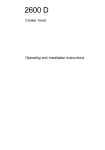Download Lavamat W80 User Manual
Transcript
LAVAMAT W 80 Washing machine Operating instructions Dear customer, Please read these operating instructions through carefully. Please make sure you read the safety instructions on the first pages of these operating instructions! Keep the operating instructions for future reference. Pass them on to any future owners. With the warning triangle and/or by means of key words (Danger!, Caution!, Attention!), information is emphasized which is important for your safety or the correct functioning of the appliance. It is essential that this information is observed. 0 This symbol guides you step by step when operating the appliance. 1 3 Next to this symbol you receive additional information and practical tips on using the appliance. 2 Tips and information about the economical and environmentally friendly use of the machine are marked with the clover. These operating instructions contain information about how to independently solve any problems which may arise. See "Troubleshooting". If this information is not sufficient, please contact your local Customer Service Centre. Addresses and phone numbers can be found in the separate “Guarantee Conditions/Service Departments“ (supplied with the appliance). In connection with this please refer to the "Service" section. Printed on environmentally friendly paper. Whoever thinks ecologically also acts ecologically .... 2 Contents Contents Contents . . . . . . . . . . . . . . . . . . . . . . . . . . . . . . . . . . . . . . . . . . . . . . . . . . . . . . 3 Safety instructions . . . . . . . . . . . . . . . . . . . . . . . . . . . . . . . . . . . . . . . . . . . . . 5 Disposal . . . . . . . . . . . . . . . . . . . . . . . . . . . . . . . . . . . . . . . . . . . . . . . . . . . . . . 7 Environmental tips . . . . . . . . . . . . . . . . . . . . . . . . . . . . . . . . . . . . . . . . . . . . . 7 The chief features of your appliance . . . . . . . . . . . . . . . . . . . . . . . . . . . . . 8 Appliance structure . . . . . . . . . . . . . . . . . . . . . . . . . . . . . . . . . . . . . . . . . . . . Front view . . . . . . . . . . . . . . . . . . . . . . . . . . . . . . . . . . . . . . . . . . . . . . . . . . . . Control panel . . . . . . . . . . . . . . . . . . . . . . . . . . . . . . . . . . . . . . . . . . . . . . . . . Program selector . . . . . . . . . . . . . . . . . . . . . . . . . . . . . . . . . . . . . . . . . . . . Program selector as progress indicator . . . . . . . . . . . . . . . . . . . . . . . . . . Temperature selector . . . . . . . . . . . . . . . . . . . . . . . . . . . . . . . . . . . . . . . . . Final spin speed button . . . . . . . . . . . . . . . . . . . . . . . . . . . . . . . . . . . . . . . Button o (RINSE HOLD) . . . . . . . . . . . . . . . . . . . . . . . . . . . . . . . . . . . . . Pilot light . . . . . . . . . . . . . . . . . . . . . . . . . . . . . . . . . . . . . . . . . . . . . . . . . . Drawer for detergent and conditioner . . . . . . . . . . . . . . . . . . . . . . . . . . . . . Consumption values and time requirement for selected programs . . . . . . 9 9 10 10 12 12 12 12 12 13 14 Before using your machine for the first time . . . . . . . . . . . . . . . . . . . . . 14 Preparing the washing cycle . . . . . . . . . . . . . . . . . . . . . . . . . . . . . . . . . . . . Sorting out and preparing washing . . . . . . . . . . . . . . . . . . . . . . . . . . . . . . . . Types of washing and care symbols . . . . . . . . . . . . . . . . . . . . . . . . . . . . . . . . Washing powders and conditioners . . . . . . . . . . . . . . . . . . . . . . . . . . . . . . . . Which washing powder and conditioner? . . . . . . . . . . . . . . . . . . . . . . . . How much washing powder and fabric softener? . . . . . . . . . . . . . . . . . Using a water softener . . . . . . . . . . . . . . . . . . . . . . . . . . . . . . . . . . . . . . . . . . 15 15 15 16 16 17 17 Execute a washing cycle . . . . . . . . . . . . . . . . . . . . . . . . . . . . . . . . . . . . . . . . Brief instructions . . . . . . . . . . . . . . . . . . . . . . . . . . . . . . . . . . . . . . . . . . . . . . . Fill-in the laundry . . . . . . . . . . . . . . . . . . . . . . . . . . . . . . . . . . . . . . . . . . . . . . Add detergent/conditioner . . . . . . . . . . . . . . . . . . . . . . . . . . . . . . . . . . . . . . . Set the washing program . . . . . . . . . . . . . . . . . . . . . . . . . . . . . . . . . . . . . . . . Start the washing program, set the final spin speed or select Rinse Hold . . . . . . . . . . . . . . . . . . . . . . . . . . . . . . . . . . . . . . . . . . . . . During the washing program . . . . . . . . . . . . . . . . . . . . . . . . . . . . . . . . . . . . . If washing cycle is completed/remove the washing . . . . . . . . . . . . . . . . . . 18 18 19 20 21 21 22 22 3 Contents Program tables . . . . . . . . . . . . . . . . . . . . . . . . . . . . . . . . . . . . . . . . . . . . . . . . Washing . . . . . . . . . . . . . . . . . . . . . . . . . . . . . . . . . . . . . . . . . . . . . . . . . . . Separate rinse . . . . . . . . . . . . . . . . . . . . . . . . . . . . . . . . . . . . . . . . . . . . . . . Separate gentle rinse/starch/conditioning . . . . . . . . . . . . . . . . . . . . . . . Separate spin . . . . . . . . . . . . . . . . . . . . . . . . . . . . . . . . . . . . . . . . . . . . . . . Separate pre wash . . . . . . . . . . . . . . . . . . . . . . . . . . . . . . . . . . . . . . . . . . . 23 23 24 24 24 25 Cleaning and caring . . . . . . . . . . . . . . . . . . . . . . . . . . . . . . . . . . . . . . . . . . . In daily use . . . . . . . . . . . . . . . . . . . . . . . . . . . . . . . . . . . . . . . . . . . . . . . . . . . . Cleaning the operating panel . . . . . . . . . . . . . . . . . . . . . . . . . . . . . . . . . . . . . Control panel . . . . . . . . . . . . . . . . . . . . . . . . . . . . . . . . . . . . . . . . . . . . . . . Detergent compartment . . . . . . . . . . . . . . . . . . . . . . . . . . . . . . . . . . . . . . Washing machine drum . . . . . . . . . . . . . . . . . . . . . . . . . . . . . . . . . . . . . . Precautionary measures in the event of a risk of frost . . . . . . . . . . . . . . . . 26 26 26 26 26 27 27 What to do, if… . . . . . . . . . . . . . . . . . . . . . . . . . . . . . . . . . . . . . . . . . . . . . . . Trouble Shooting . . . . . . . . . . . . . . . . . . . . . . . . . . . . . . . . . . . . . . . . . . . . . . . If the washing results are not satisfactory . . . . . . . . . . . . . . . . . . . . . . . . . . Perform emergency drain . . . . . . . . . . . . . . . . . . . . . . . . . . . . . . . . . . . . . . . . Clean suds pump . . . . . . . . . . . . . . . . . . . . . . . . . . . . . . . . . . . . . . . . . . . . . . . 28 28 30 31 32 Technical data . . . . . . . . . . . . . . . . . . . . . . . . . . . . . . . . . . . . . . . . . . . . . . . . 33 Power supply . . . . . . . . . . . . . . . . . . . . . . . . . . . . . . . . . . . . . . . . . . . . . . . . . . 33 Information for the electrician . . . . . . . . . . . . . . . . . . . . . . . . . . . . . . . . . . . 33 Index . . . . . . . . . . . . . . . . . . . . . . . . . . . . . . . . . . . . . . . . . . . . . . . . . . . . . . . . . 34 Service . . . . . . . . . . . . . . . . . . . . . . . . . . . . . . . . . . . . . . . . . . . . . . . . . . . . . . . 35 4 Safety instructions 1 Safety instructions The safety standards of AEG electric appliances are in keeping with the recognised rules of technology and the law governing the safety of appliances. Nevertheless as a manufacturer we are committed to familiarise you with the following safety instructions: General safety • Repairs to the washing machine may only be carried out by qualified personnel. As a result of incorrect repairs considerable dangers for the user may result. Please contact our customer service department or an authorised AEG dealer in the event of repairs being necessary. • Never start the washing machine if the mains flex is damaged or the control panel, work top or base area are so damaged that the inside of the washing machine is accessible. • Switch off the washing machine before carrying out any cleaning, care and maintenance work! You can make totally sure by pulling the mains plug out of the socket or - if permanently connected – by switching off the fuse switch in the fuse box or by unscrewing the plug fuse right out. • Multiway plugs, joints and extension cables must not be used. There is a fire risk with overheating! • Never use the flex to pull the plug out of the socket but pull the actual plug. • Do not spray the washing machine with a water jet – danger of an electric shock! • During washing programs at a high temperature, the glass of the door heats up. Do not touch! • Allow the suds to cool down before cleaning the pump or carrying out emergency emptying. • Small animals can nibble at power cables and water hoses. Electric shock hazard and danger of damages from water! Installation, connection and initial operation • Please follow the separate Installation and connection instructions. • Run the first washing cycle without washing (t / COTTONS 95, with half the amount of washing powder) to remove residues on the drum and suds container caused during production. 5 Safety instructions • If the machine is delivered during the winter at freezing temperatures: store the washing machine for 24 hours at room temperature before starting it. Safety of children • Often children are not aware of the dangers involved in handling electrical equipment. Therefore please ensure they are adequately supervised whilst the appliance is on and do not allow children to play with the washing machine – there is a risk that the children may lock themselves in the appliance. • Packaging (e.g. plastic films, polystyrene) could be dangerous for children – danger of suffocation! Keep packaging away from children. • Please make sure that children or small animals do not climb into the drum of the washing machine. • When disposing of the washing machine pull out the plug, cut off the flex, dispose of the plug and remaining flex and destroy the door lock. This hinders children from locking themselves in and endangering their lives. Intended use • Only use the washing machine to wash normal domestic washing. If the washing machine is used for any other purpose or is incorrectly used, the manufacturer adopts no liability for any damages which may result. • Conversions or changes to washing machines are not permitted due to safety reasons. • Only use washing powder which is suitable for washing machines. Please follow the instructions of the washing powder manufacturers. • The washing may not contain any flammable solvents. Please observe this above all when washing prewashed laundry. • Do not use your washing machine for dry cleaning. • Dyes and bleaching agents may only be used if specifically permitted by the manufacturer of these products. We cannot be held liable for any damages. • Please only use water from the mains. Only use rain or industrial water if it meets the requirements of DIN1986 and DIN1988. 6 Disposal 2 Disposal Dispose of the packaging! Dispose of the packaging material of your washing machine correctly. All packaging materials are environmentally friendly and can be disposed of without any danger or burnt in the refuse incinerator. The plastic parts can be reused: • The external plastic cover and the bags inside are made of polyethylene (marking >PE<). • The padding is made of CFC free expanded polystyrene (marking >PS<). The boxes are made from recycled paper and should be returned to the old paper collection. Dispose of your old washing machine! When you eventually stop using your washing machine please bring it to the nearest recycling centre or to your dealer who will take it back for a small fee. 2 Environmental tips • For normally soiled washing you do not need a prewash. In this way you can save washing powder, water and time (and not pollute the environment!). • The washing machine works particularly economically if you exploit the maximum loads. • For small quantities of washing use half to two thirds of the recommended washing powder quantity. • By suitable pretreatment stains and a certain amount of dirt can be removed. Then you can wash at a low temperature. • Wash slightly soiled to normally soiled cottons with the energy saving program. • Often you do not need a fabric softener. Just try it! If you use a washing machine your washing will become soft and fluffy without softener. • For medium to high water hardness (from hardness range II, see "Washing powder and conditioners") you should use a water softener. The washing powder can then always be measured as for hardness area I (= soft). 7 The chief features of your appliance The chief features of your appliance • Program setting by means of program selector and temperature selector • Energy saving program for lightly to normally soiled cottonwashing. • Maximum spin speed 800 revolutions per minute. • The speed can be changed to 400 revolutions per minute. • Rinse hold can be selected (button o): the washing is left in the last rinse water, it is not spun. • Automatic control with fuzzy logic: sensor regulated wash process, the amount of water used is dependent on foam and loading. This ensures the best washing and rinsing results with the lowest, automatically adjusted water consumption. • 3 Chamber Drawer for detergent and conditioner • ECO valve: ensures one hundred percent detergent usage by automatically closing the water container during washing. • Scooping ribs in the drum: rapid and even wetting of the washing. • Imbalance control system: stability and quiet running. • Allround Water Protection. 8 Appliance structure Appliance structure Front view Control panel Drawer for detergent and conditioner Rating plate (behind door) Door with handle Flap in front of suds pump Height adjustment, adjustable-screw feet 9 Appliance structure Control panel Program selector Temperature selector Final spin speed button Button RINSE HOLD Pilot light Program selector You switch the washing machine on and off using the program selector. – Switching on: Pull out program selector. – To switch off the machine: press in the program selector Furthermore, you determine the washing cycle via the program selector. Different setting positions have the following effect: 10 Appliance structure Program group t/} (COTTONS/LINEN, EASY-CARES) • Position 1 (COTTONS/LINEN) Main washing cycle for normally to heavily soiled cottons/linen (wash – rinse/gentle rinse – spin) • Position 2 (EASY-CARES) Main washing cycle for easy-care fabrics. • Position 3 (QUICK WASH) Shortened main-wash cycle for lightly dirty washing. • Position 4 (RINSE) Separate rinse, e.g. for rinsing hand-washed fabrics (spin according to the selected washing cycle). • Position 5 (FABRIC SOFTENING) Separate rinse, separate starch, separate conditioning (one rinse is run, liquid conditioner is washed in from the À compartment). • Position 6 (SPIN) Spinning after rinse hold, or separate spinning of hand washed textiles Program group à (DELICATES) • Position 7 (DELICATES) Main wash cycle for delicates (Wash rinse/conditioner – short spin). • Position 8 (SHORT SPIN) Spin after Rinse Holds or separate protective spin of hand-washed delicates Program group s (WOOLLENS) • Position 9 (WOOL) Main wash cycle for wool and especially sensitive fabrics (Wash–conditioner – short spin). • Position 10 (GENTLE RINSE) Separate protective rinse, e.g. for rinsing hand-washed fabrics (1 Rinse cycle and subsequent short spin). • Position 11 (SHORT SPIN) Spin after Rinse Holds or separate short spin of hand-washed woollen and especially sensitive fabrics. 11 Appliance structure k PREWASH: Separate PRE WASH (approx. 20 minutes by maximum 40° C) and subsequent pumping out. 3 After PRE WASH, the main wash cycle must be set as desired, the program does not continue automatically. v PUMP OUT Pump out the water after rinse hold (without spinning). Program selector as progress indicator The program selector serves as a progress indicator by moving clockwise until the end of the program is reached. Temperature selector You can set the following temperatures on the temperature selector: r (cold), 30, 40, 50, 60, E, 70, 80, 95 2 Position E (Energy Saving Program) is suitable for lightly to normally soiled cottons; temperature reduced to approx. 67°C. Final spin speed button With this button you can change the maximum speed for the final spin. Button o (RINSE HOLD) With the Rinse Hold setting the washing is left in the final rinse water and is not spun. Pilot light The pilot light is illuminated as soon as the washing machine is switched on. It is extinguished when a washing program is finished. 12 Appliance structure Drawer for detergent and conditioner Suction lift cap (must be firmly fitted) k Compartment for pre wash detergent. Washed in right at the start of the washing program when the k (PRE WASH) position is selected. l Compartment for powdered main wash detergent and, if necessary, water softener. Washed in at the start of the main washing cycle. w Compartment for liquid conditioner (fabrik softener, finisher, starch). Washed in during the last rinse. 13 Before using your machine for the first time Consumption values and time requirement for selected programs The values in the following table were calculated under standard conditions. They provide a useful guide for operation in the home. Program selector Temperature selector Type of washing Load in kg Water in litre Energy in kWh Time in minutes 95 Cottons/ Linen 5 59 1.80 119 60 Cottons/ Linen 5 59 1.10 119 40 Cottons/ Linen 5 59 0.60 119 Position 2 (EASY-CARES) 40 Easy-cares 2.5 48 0.40 86 Position 7 (DELICATES) 30 Delicates 2.5 57 0.45 67 Position 9 (WOOL) 30 Wool 2 52 0.35 67 Position 1 (COTTONS/ LINEN) Before using your machine for the first time 0 Slightly pull the detergent compartment out of the control panel. 0 Pour about 1 litre of water through the detergent compartment into the washing machine. Only once this has been done does the suds container close and the ECO valve can function correctly. 0 Run through a wash cycle without washing (t/ COTTONS 95, with half the amount of washing powder). This removes residues on the drum and suds container caused during production. 14 Preparing the washing cycle Preparing the washing cycle Sorting out and preparing washing • Sort out washing according to the type and care symbol (see "Types of washing and care symbols"). • Empty the pockets. • Remove any metal parts (paper clips, safety pins etc.). • To prevent washing from getting damaged and forming bundles: close zips, button up duvet covers and pillow cases, tie up loose straps such as from aprons. • Turn clothes made from double layer fabric inside out (e.g. anoraks, sleeping bags). • For knitted coloured fabrics as well as woollens and fabrics with appliqué: turn inside out. • Put small and delicate pieces (baby socks, tights) in a washing net, a pillow case with zip or in larger socks. • Handle curtains with special care. Remove metal strips or plastic fins or tie them in a net or a bag. We accept no liability for damages. • Keep coloureds and whites separately in different washing cycles, otherwise whites will turn grey. • New coloured fabric often contains excess dyes. Wash this laundry separately for the first time. • Mix small and large pieces of washing! This improves the effectiveness of the wash and the washing is distributed better when spinning. • Shake out washing before putting it into the machine. • Unfold the washing before putting it into the drum. Types of washing and care symbols The care symbols help to choose the correct washing program. The washing should be sorted according to the type and care symbol. The temperature specifications in the care symbols are always maximum specifications. 15 Preparing the washing cycle Cottons ç Fabrics made of cotton and linen with this care symbol are not sensitive towards mechanical strain and high temperatures. The t (COTTONS/LINEN) program is suitable for this type of washing. Linens è ë Fabrics made of cotton and linen with this care symbol are not sensitive towards mechanical strain. The t (COTTONS/LINEN) program is suitable for this type of washing. Easy care washing ê í î Fabrics such as finished cottons, cotton mixtures and synthetics with this care symbol require a softer mechanical treatment. The } (EASY-CARES) program is suitable for this type of washing. Delicates ì Fabrics such as layered fabrics, microfibres, synthetics, curtains with this care symbol require a very gentle treatment. The à (DELICATES) program is suitable for this type of washing. Woollens and very delicate types of washing 9 ì Fabrics such as wool, wool mixtures or silk with this care symbol react very sensitively to mechanical stress. The s (WOOLLENS) program is suitable for this type of washing. Woollens with 9 (wool mark) may only be washed in the washing machine if they bear the addition "does not felt" or "suitable for machine washing". Fabrics with the care symbol ï (Hand washing) or ñ (Do not wash!) may not be washed in the washing machine! Please follow care instructions "wash separately" and "wash separately several times"! Washing powders and conditioners Which washing powder and conditioner? Only use washing powders and fabric softeners suitable for washing machine use. As a general rule follow the instructions of the producers. 16 Preparing the washing cycle How much washing powder and fabric softener? The amount to be used depends on • the load: If the washing powder producer does not make any specifications for small loads, use a third less for half loads, and for very small loads only use half of the amount of washing powder recommended for a full load. • the degree of soiling of the washing: For only slightly soiled washing use less washing powder. Follow the instructions of the washing powder producer and load. • on the degree of hardness of the tap water: The harder the water, the higher the dosage! You will find the quantities to use according to water hardness on the washing powder packaging. Liquid detergent Add liquid detergent using the measuring cup provided by the detergent industry. Please follow the instructions on the package. Using a water softener For a medium to high degree of water hardness (from water hardness area II) water softener should be used. Follow the manufacturers instructions! Then always dose detergent for hardness area I (= soft). You can find information about the local degree of water hardness from your water utility. Specifications of water hardness Water hardness in °dH (degrees of German hardness) Water hardness in mmol/l (Millimol per litre) I - soft 0-7 up to 1,3 II - medium hard 7 - 14 1,3 - 2,5 III - hard 14 - 21 2,5 - 3,8 above 21 above 3,8 Water hardness IV - very hard 17 Execute a washing cycle Execute a washing cycle Brief instructions 0 0 0 0 0 0 A washing cycle proceeds in the following steps: Open the door, fill in the washing. Shut the door. Add detergent/conditioner. Set the correct washing program: – Set the program via the program selector; – Set the temperature via the temperature selector; Pull out program selector. Washing program starts automatically after six seconds. If necessary change the final spin speed or press the o (RINSE HOLD) button. You can alter this setting and the temperature during the entire washing cycle. After the washing program runs out: Important! If the washing cycle ends with a rinse hold, either PUMP OUT the water (position v) or perform a SPIN (position 6) or SHORT SPIN (position 8 for delicates or position 11 for wool) prior to opening the door. 0 Open the door, remove the washing. 0 Press in the program selector. This switches the washing machine off. 18 Execute a washing cycle Fill-in the laundry 0 Sort and prepare washing according to type. For instructions for correct preparation of the washing, see "Washing types and treatment symbols." 0 Open door: pull at the handle of the door. 0 Fill the washing. 3 3 Maximum filling quantity see "Program tables". 0 Close the door tightly. Attention! When closing the door do not catch any washing pieces! Textiles and appliance could be damaged. 19 Execute a washing cycle Add detergent/conditioner 0 Pull out compartment up to stop limit. 0 Fill in detergent/conditioner. 3 For instructions on detergent and conditioners, see "Detergent and Conditioners". k Compartment for pre wash detergent. Washed in right at the start of the washing program when the k (PRE WASH) setting is selected. l Compartment for powdered main wash detergent and, if necessary, water softener. Washed in at the start of the main washing cycle. w Liquid conditioner (fabrik softener, finisher, starch). Attention! Fill the compartment at the most up to the MAX mark. Thick liquid detergents are eventually diluted up to the MAX mark, powdered starch is dissolved. 0 Push in the compartment quite inside. 20 Execute a washing cycle Set the washing program 3 Suitable program and correct temperature for the respective type of washing, see "Program Tables." Set the washing program Attention! Program selector may only be rotated clockwise! 0 Set the program selector on the desired washing program Set the temperature 0 Set the temperature selector to the temperature desired. Start the washing program, set the final spin speed or select Rinse Hold 0 Check whether the water tap is opened. 0 Activate the washing machine: Pull program selector. The pilot light lights up, the washing program starts automatically after six seconds. 0 If necessary reduce the final spin speed for the final spin or select Rinse Hold. – Press the final spin speed button or – press the button o (RINSE HOLD). If Rinse Hold has been selected, the washing remains in the final rinse water and is not spun. 21 Execute a washing cycle During the washing program You can at any time – alter the setting of the final spin speed, – press the button o (RINSE HOLD), – alter the temperature setting; Other settings cannot be altered. To stop the washing program before it is finished : 0 Push in program selector. 0 Turn the program selector clockwise to v (PUMP OUT). 0 Pull out program selector. If washing cycle is completed/remove the washing The washing program normally ends with the final spin. 0 0 0 0 0 0 0 22 After Rinse Hold: After a Rinse Hold the water must be pumped out first or the washing spun: Release the o (RINSE HOLD) button. Turn the program selector clockwise to – Position 6 (SPIN) or – Position 8 for delicates or position 11 for woollens (SHORT SPIN). Washing is spun in accordance with the program group selected and the final spin speed set, or – v (PUMP OUT). The water is pumped out. Open the fill-in door. Remove the washing. Press in the program selector. The washing machine is now off. Close the water tap. Pull out the detergent compartment a little bit, so that it can dry out. Leave door slightly open so that the washing machine can ventilate. Program tables Program tables Washing Not all possible settings are listed in the following, apart from the dayto-day common settings and those that are deemed reasonable. Washing Types, Care Symbols Cottons ç max. load (dry weight)1 5kg Postion 1 (COTTONS/LINEN) 95 Position 3 (QUICK WASH) 95 Energy Saving Program: Postion 1 (COTTONS/LINEN) Linen è ë 5kg Temperature selector Program selector Postion 1 (COTTONS/LINEN) Position 3 (QUICK WASH) Position 2 (EASY-CARES) E 30-60 Easy-Cares ê í î 2.5kg Delicates ì 2.5kg (or 15-20m2 curtains) Position 7 (DELICATES) r (cold) up to 40 Wool2 9 ì 2kg Position 9 (WOOL) r (cold) up to 40 Position 3 (QUICK WASH) 30-60 1) A 10-litre bucket contains about 2,5kg of dry washing (cotton). 2) Woollen clothing with woollen symbol may only be washed in the machine if the complement "does not felt," "non-felting" or "washing machine resistant" is included. 23 Program tables Separate rinse Max. filling quantity (dry weight) Type of washing Cottons/Linen 5kg Easy-Cares 2.5kg Delicates 2.5kg Wool 2kg Program selector Position 4 (RINSE) Position 10 (GENTLE RINSE) Separate gentle rinse/starch/conditioning Max. filling quantity (dry weight) Type of washing Cottons/Linen 5kg Easy-cares 2.5kg Delicates 2.5kg Woollens 2kg Program selector Position 5 (FABRIC SOFTENING) Position 10 (GENTLE RINSE) Separate spin Max. filling quantity (dry weight) Type of washing 24 Program selector Cottons/Linen 5kg Easy-cares 2.5kg Delicates 2.5kg Position 8 (SHORT SPIN) Woollens 2kg Position 11 (SHORT SPIN) Position 6 (SPIN) Program tables Separate pre wash Type of washing Max. filling quantity (dry weight) Cottons/Linen 5kg Easy-Cares 2.5kg Delicates 2.5kg Program selector Position k (PREWASH) Temperatureselector r (cold) up to 40 25 Cleaning and caring Cleaning and caring In daily use 0 After the program has finished pull out the detergent compartment a little so that it can dry out. 0 Only lean the door to after washing so that the washing machine is aerated from the inside and can dry out. 0 Close the tap. Cleaning the operating panel Control panel Attention! Do not use household furniture polish or aggressive detergents to clean the panel and operating parts 0 Wipe over the operating panel with a damp cloth. Only use warm water. Detergent compartment Now and again the detergent compartment should be cleaned. 0 Pull out the detergent compartment as far as it will go. 0 Remove the detergent compartment by pulling heftily. 0 Remove the suction cap. 0 Clean suction cap under running water. 0 Clean the separate compartments with warm water from the back. A bottle brush is a useful help here. 0 Push on the suction cap until the stop, so that it is sitting tightly. 26 Cleaning and caring 0 Clean the entire compartment area of the washing machine with a brush. 0 Insert the detergent compartment into the guides and push it in. Washing machine drum The washing machine drum is made from rust-free stainless steel. Rusty foreign bodies in the washing can cause rust deposits on the drum. Attention! Do not clean the stainless steel drum with descaling agents containing acids, scouring agents containing chlorine or iron or steel wool. Our customer service department has suitable agents available. 0 Remove rust deposits on the drum with a stainless steel cleansing agent. Door 0 Regularly check if there are deposits or foreign bodies in the rubber sleeve behind the door and remove them if applicable. Precautionary measures in the event of a risk of frost Damages caused by frost are not covered by the warranty! If the washing machine is in a room with a risk of freezing, in the event of a risk of freezing, an emergency emptying has to be done (see "Executing an emergency emptying"). Additionally: 0 Unscrew the inlet hose from the tap and place it on the floor. 3 27 What to do, if… What to do, if… 3 The somewhat different, in comparison to older washing machines, whistling noise during spinning is due to the modern drive system. Trouble Shooting In the case of a malfunction try to solve the problem with the aid of the notes given here. If you call in customer service to resolve one of the malfunctions listed here, or an error in operating the machine, the customer service engineer’s visit is not cost free, even during the period of guarantee. Malfunction Possible Cause Mains plug is not plugged in. Washing machine does House fuse in defective. not work. The machine does not take in water. Washing machine vibrates during operation or is unstable. 28 Remedy Insert mains plug. Replace fuse or reset. Appliance is not switched on. Switch on the appliance (pull out program selector). Door is not closed properly. Close door, lock must engage audibly Tap is closed. Open tap. Sieve in the threaded fitting on the water inlet hose is blocked. Unscrew the hose from the tap, remove the sieve and clean under running water The height adjustable threaded feet are not correctly adjusted. Adjust the feet as per the installation and connection instructions. There is only very little washing in the drum (e.g. only a Does not impair function. toweling dressing gown). Water could not be completely pumped out prior to spinning because – Drain hose is kinked or – circulation pump is blocked. Check the drain hose and if necessary remove any kink or clean the circulation pump and remove any foreign bodies from the pump housing. What to do, if… Malfunction Possible Cause Remedy Dose detergent exactly in Excessive foaming dur- Probably too much detergent accordance with the manuing the main wash. was used facturer’s instructions. Threaded fitting on the water inlet hose is leaking. Tighten the water inlet hose Drain hose is leaking. Check drain hose and if necessary replace. Circulation pump cover is not closed properly. Close cover properly. Washing is trapped in the door. Stop program, remove washing from the door, start a new program. Softener is not washed in, compartment w for conditioner is full with water. Suction cap in the compartment for conditioner is not correctly positioned or is blocked. Clean detergent drawer, place suction cap firmly in position. Appliance does not spin, water in the drum. Rinse Hold selected. Deselect Rinse Hold. Drain hose is kinked. Remove kink. Maximum pumping height (drain height 1m above the floor on which the machine is standing) exceeded. Please contact customer service who have a retrofit kit for pumping to heights of greater than 1m. Circulation pump is blocked. Switch off the machine and unplug from the mains, clean the circulation pump. In the case of siphon connection: siphon is blocked. Clean siphon. It is not possible to open the door. The door is locked due to safety reasons. Wait 2 to 3 minutes after the end of the program. Rinse water is cloudy. This probably due to a deter- No negative impact on the gent with a high silicate con- rinsing results, possibly use tent. liquid detergent. Water runs out from under the washing machine. Washing is not spun properly, water is still visible in the drum. 29 What to do, if… If the washing results are not satisfactory If the washing is gray and scale has built up in the drum. • Too little detergent was used. • The wrong detergent was used. • Special soiling was not pre-treated. • Program or temperature not set correctly. • When using component detergents, the individual components were not used in the correct proportions. If there are still gray stains on the washing • Washing soiled with ointments, grease or oils was washed with too little detergent. • Too lower temperature was used for washing. • A common cause is that softener – particularly that in concentrated form – has got onto the washing. Wash out any such spots as quickly as possible and use that particular softener carefully. If at the end of the last rinse foam is still visible • Modern detergents can cause foam also in the last rinse. The washing is however sufficiently rinsed. If there are white remnants on the washing • This is an insoluble material contained in modern detergents. This is not the result of unsatisfactory rinsing. Shake or brush washing. Perhaps you should turn the washing inside out before washing in future. Reconsider choice of detergent, possibly use liquid detergent. 30 What to do, if… Perform emergency drain 1 Warning! Switch off the washing machine and pull the mains plug before an emergency drain! If the washing machine no longer pumps out the water then an emergency drain must be performed. Attention! The water which runs out of the emergency draining hose can be hot. There is a danger of scolding! Before an emergency drain first allow the water to cool down! 0 Have a flat container on hand to catch the water running out. 0 Fold down and remove the flap on the left of the base cover. 0 Undo the emergency drain hose from the mounting. 0 Pull the emergency drain hose out a little. 0 Place the container under the hose. 0 Undo and remove the emergency drain hose end plug by turning it in an anticlockwise direction. The water runs out. Depending on the amount of water it may be necessary to empty the container several times. Temporarily close the emergency drain hose again with the end plug. When the water is completely drained: 0 Press the end stop firmly back into the emergency drain hose. 0 Push the emergency drain hose back in a little and allow it to snap into the mounting. 0 Put on the flap and close. 3 The ECO valve does not function when the machine has been fully emptied. Therefore add approx. 1liter of water before the next wash (pour in through the detergent drawer). 31 What to do, if… Clean suds pump 1 Warning! Switch off the washing machine and pull the mains plug before cleaning the suds pump! 0 Next perform an emergency drain (see section above "Perform emergency drain"). 0 Lay a cloth on the floor in front of the suds pump cover. Some water may run out. 0 Undo the cover on the suds pump in an anti-clockwise direction and remove. 0 Remove foreign body from the pump housing. 0 Check whether the pump impeller can be turned. (A jerky pump motion is normal.) If the impeller cannot be turned, inform customer service. 0 Replace cover (insert the stud on the cover into the guide slot) and tighten in clockwise direction. 0 Close emergency drain hose, push in and fix in place. 0 Close the flap. 32 Technical data Technical data Country of Origin Germany Rated Voltage 220 V Rated Frequency 60 Hz Rated Input 10 A Total maximum rated input of motors 200 W Height x width x depth 85x60x60cm Depth with the door opened 95cm Height adjustability approx. +10/-5mm Empty weight approx. 85kg Full load (depending on the program) max. 5kg Area of application household Drum speed when washing max. 53rpm-1 Drum speed when spinning see rating plate 2 Water pressure 1-10bar (=10–100N/cm = 0.1–1.0MPa) ; This appliance complies with the following EC directives: • 73/23/EEC of 19/2/1973 ’Low voltage directive’ • 89/336/EEC of 3/5/1989 ’EMC directive’ including the Modification directive 92/31/EEC Power supply Please refer to the rating plate for specifications about the power supply. The nominal voltage stated on the rating plate and type of current must be identical with the nominal voltage and type of current at the point of installation. Also refer to the rating plate for the fuse required. Information for the electrician When connecting the appliance without a plug, care must be taken that this is done correctly. Please follow the relevant information in the "Installation and connection instructions" section. For appliances with variable voltage settings, the switch-over diagram can be found on the cover of the connection box at the back of the appliance. 33 Index A Q Automatic control . . . . . . . . . . . . . . . . . . . . . 8 Quick wash . . . . . . . . . . . . . . . . . . . . . . 11, 23 C R Conditioner . . . . . . . . . . . . . . . . . . . 9, 13, 20 Conditioning . . . . . . . . . . . . . . . . . . . . . . . . 24 Cotton mixtures . . . . . . . . . . . . . . . . . . . . . 16 Cottons . . . . . . . . . . . . . . . 11, 16, 23, 24, 25 Curtains . . . . . . . . . . . . . . . . . . . . . . . . .15, 16 Customer service . . . . . . . . . . . . . . . . . . . . . 27 Rating plate . . . . . . . . . . . . . . . . . . . . . . 9, 35 Rinse . . . . . . . . . . . . . . . . . . . . . . . . . . . 11, 24 Rinse hold . . . . . . . . . . . . . . . . . . . . .8, 21, 22 D Delicates . . . . . . . . . . . . . . 11, 16, 23, 24, Detergent . . . . . . . . . . . . . . . . . . . . . 9, 13, liquid . . . . . . . . . . . . . . . . . . . . . . . . . . . . remnants . . . . . . . . . . . . . . . . . . . . . . . . . 25 20 17 30 E Easy-cares . . . . . . . . . . . . 11, 16, 23, 24, 25 ECO valve . . . . . . . . . . . . . . . . . . . . . 8, 14, 31 Energy saving program . . . . . . . . . . 8, 12, 23 F Fabric softener . . . . . . . . . . . . . . . . 7, 13, 20 Finisher . . . . . . . . . . . . . . . . . . . . . . . . . . . . . 20 G Gentle rinse . . . . . . . . . . . . . . . . . . . . . .11, 24 H Hand washing . . . . . . . . . . . . . . . . . . . . . . . 16 L Linen . . . . . . . . . . . . . . . . . 11, 16, 23, 24, 25 Liquid detergent . . . . . . . . . . . . . . . . . . . . . 17 M Main wash detergent . . . . . . . . . . . . . .13, 20 Microfibres . . . . . . . . . . . . . . . . . . . . . . . . . . 16 O Open door . . . . . . . . . . . . . . . . . . . . . . .19, 29 P Perform emergency drain . . . . . . . . . . . . . 31 Pre wash . . . . . . . . . . . . . . . . . . . . . . . . .20, 25 Pre wash detergent . . . . . . . . . . . . . . . .13, 20 Program stop . . . . . . . . . . . . . . . . . . . . . . . . 22 Pump out . . . . . . . . . . . . . . . . . . . . . . . . . . . 12 34 S Scale . . . . . . . . . . . . . . . . . . . . . . . . . . . . . . .30 Short spin . . . . . . . . . . . . . . . . . . . . . . . . . . .11 Silk . . . . . . . . . . . . . . . . . . . . . . . . . . . . . . . . .16 Spin . . . . . . . . . . . . . . . . . . 8, 11, 12, 21, 24 Stain . . . . . . . . . . . . . . . . . . . . . . . . . . . . 7, 30 Starch . . . . . . . . . . . . . . . . . . . . . . 13, 20, 24 Suds pump . . . . . . . . . . . . . . . . . . . . . . . 9, 32 Synthetics . . . . . . . . . . . . . . . . . . . . . . . . . . .16 W Warranty . . . . . . . . . . . . . . . . . . . . . . . . . . . .27 Washing coloured . . . . . . . . . . . . . . . . . . . . . . . . . .15 delicate . . . . . . . . . . . . . . . . . . . . . . . 15, 16 double layers . . . . . . . . . . . . . . . . . . . . . .15 easy care . . . . . . . . . . . . . . . . . . . . . . . . . .16 normally soiled . . . . . . . . . . . . . . . . . . . . . . 7 slightly soiled . . . . . . . . . . . . . . . . . . . 7, 17 unsatisfactory results . . . . . . . . . . . . . . .30 Water hardness . . . . . . . . . . . . . . . . . . . . . . . 7, 17 pump out . . . . . . . . . . . . . . . . . . . . . . . . .12 softener . . . . . . . . . . . . . . . . . 7, 13, 17, 20 Wool . . . . . . . . . . . . . . . . . . . . 11, 16, 23, 24 Service In the chapter "Troubleshooting" some disturbances have been summarised, which you can solve yourself. If you do not find any helpful information there, please contact your local Customer Service Centre. Addresses and phone numbers can be found in the separate “Guarantee Conditions/Service Departments“ (supplied with the appliance). Be well prepared before you phone. This facilitates the diagnosis and the decision as to whether a customer service visit is necessary. With our checklist you can gather important information before making your call: Make a note of the PNC number and the Serial number. They are both on the rating plate behind the door of your washing machine. PNC .................................... S no. ................................... If possible establish: • How is the disturbance evident? • Under what circumstances does the disturbance occur? When do you incur costs even during the warranty period? – if you could have solved the disturbance yourself with the help of the Troubleshooting table (see section "Troubleshooting "), – if the customer service engineer has to make several journeys because he did not receive all the necessary important information before his visit and now e.g. has to fetch spares. You can avoid these extra trips by preparing your telephone call properly in the way described above. 35 AEG Hausgeräte GmbH Postfach 1036 D-90327 Nürnberg http://www.aeg.hausgeraete.de © Copyright by AEG H 243 273 540 - 02- 0201





































